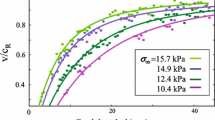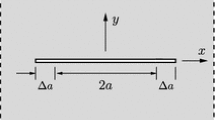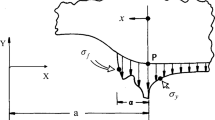Abstract
A fracture parameter, crack tip displacement factor D is introduced to characterize the two-dimensional linear elastic fracture mechanics problems. Similar to the conventional COD approach, the D factor can be determined directly from the crack surface displacement. The major advantage of using this fracture control parameter is that one can obtain it by evaluating the crack surface displacement from a numerical analysis or an experiment without the need for considering the stress field at the crack tip. Unlike the COD method, the introduced fracture parameter may be used for not only the simple opening mode but also for the sliding and tearing modes as well as for the mixed mode fracture problems. This article presents a detailed derivation of the D factor as well as some sample applications.
Similar content being viewed by others
References
A.S. Kobayashi, D.E. Maiden, B.J. Simon and S. Isida, Application of finite element analysis method to two dimensional problems in fracture mechanics, ASME paper No. 69-WA/PVP-12 (1969).
S.K. Chan, I.S. Tuba and W.K. Wilson, Engineering Fracture Mechanics 2 (1970) 1–17.
T.A. Cruse and R.B. Wilson, Boundary-integral equation method for elastic fracture mechanics, AFOSR-TR-78–0355 (Nov. 1977).
G.E. Blandford, A.R. Ingraffea and J.A. Liggett, International Journal of Numerical Methods in Engineering 9 (1981) 387–404.
L.B. Valla and T.F. Lenhoff, Engineering Fracture Mechanics 16 (1982) 557–568.
K.Y. Lee, D.S. Won and H.J. Choi, Engineering Fracture Mechanics 27 (1987) 75–82.
C.L. Chow and K.J. Lau, Journal of Strain Analysis 11 (1976) 18–25.
C.W. Woo and M.D. Kuruppu, International Journal of Fracture 20 (1982) 163–178
P.L. Levery, K.P. Chong and M.D. Kuruppu, in Proceedings, U.S. National Symposium on Rock Mechanics (1984) 38–46.
H. Feng, J. Zhang, J. Rohde and A. Ghorbanpoor, in Proceedings, 21st Mid-Western Mechanics Conference, Houghton, Michigan, August 1989.
H. Feng, J. Zhang and J. Rohde, Engineering Fracture Mechanics, accepted.
J. Zhang and A. Ghorbanpoor, in Proceedings, International Symposium for Testing and Failure Analysis, Los Angeles, California, November 1989.
A.A. Wells, in The Crack Propagation Symposium, Cranfield (1961) 210–230.
A.A. Wells, British Welding Research Association Report, M13/63 (1963).
H. Tada, P.C. Paris and G.R. Irwin, The Stress Analysis of Cracks Handbook, Paris Productions, Inc., St. Louis, Mo (1985).
J. Zhang, Boundary element analysis of fracture mechanics problems, Ph.D. dissertation, University of Wisconsin-Milwaukee, May 1991.
P.C. Paris, The mechanics of fracture propagation and solution to fracture arrester problems, Document D2–2195, The Boeing Company (1957).
I.N. Sneddon and M. Lowengrub, Crack Problems in the Classical Theorem of Elasticity, John Wiley, New York (1970).
Author information
Authors and Affiliations
Rights and permissions
About this article
Cite this article
Zhang, J., Ghorbanpoor, A. Crack tip displacement factor-D: an application to two dimensional linear elastic fracture mechanics. Int J Fract 59, 133–150 (1993). https://doi.org/10.1007/BF00012387
Received:
Accepted:
Issue Date:
DOI: https://doi.org/10.1007/BF00012387




